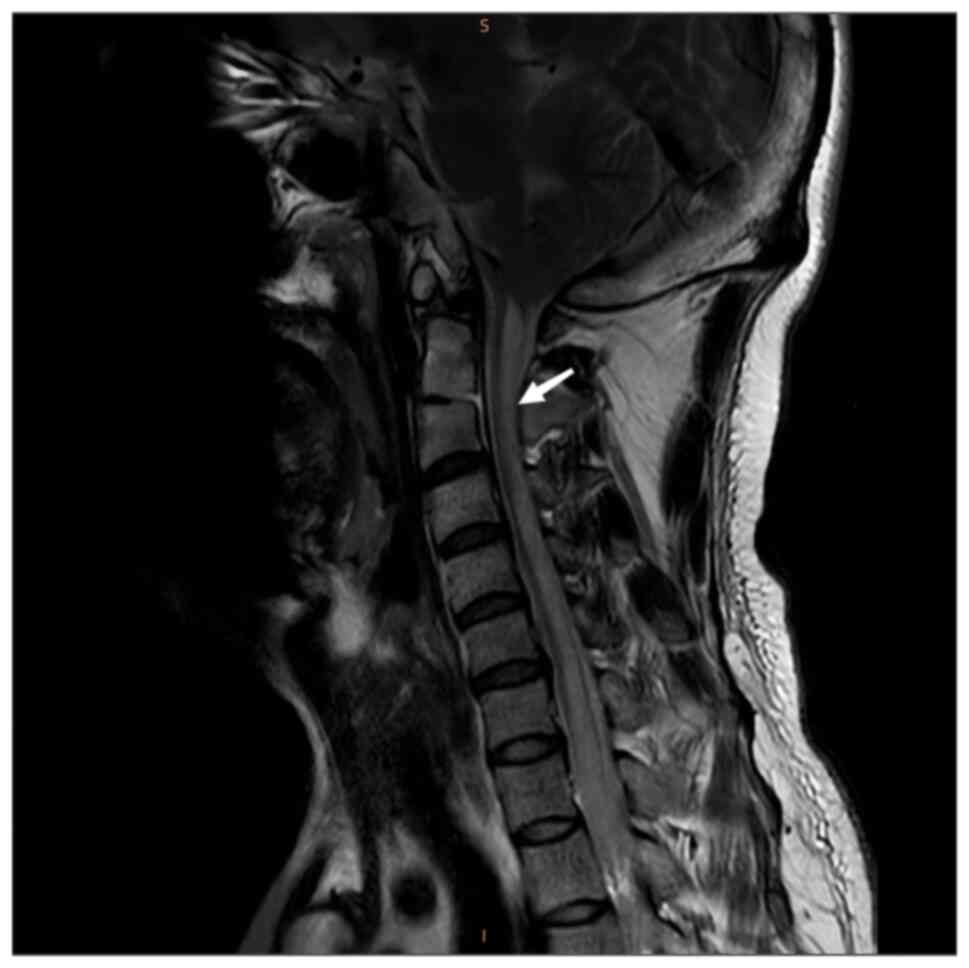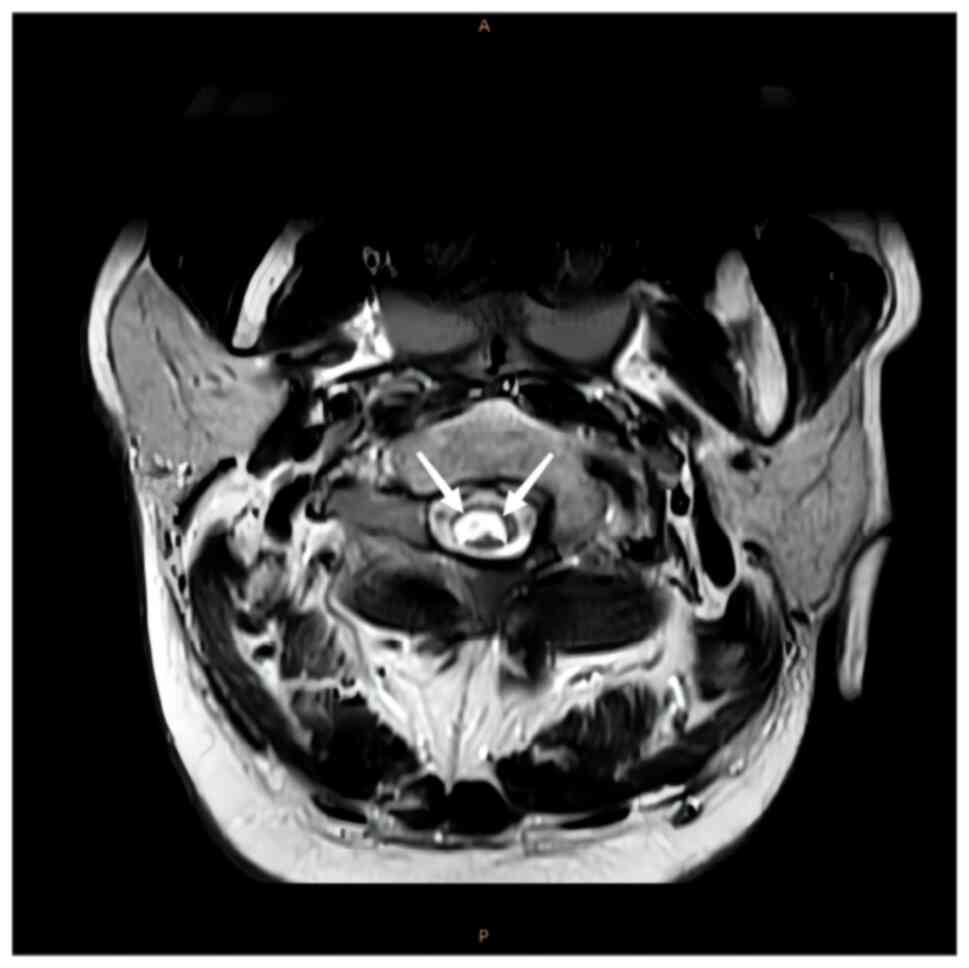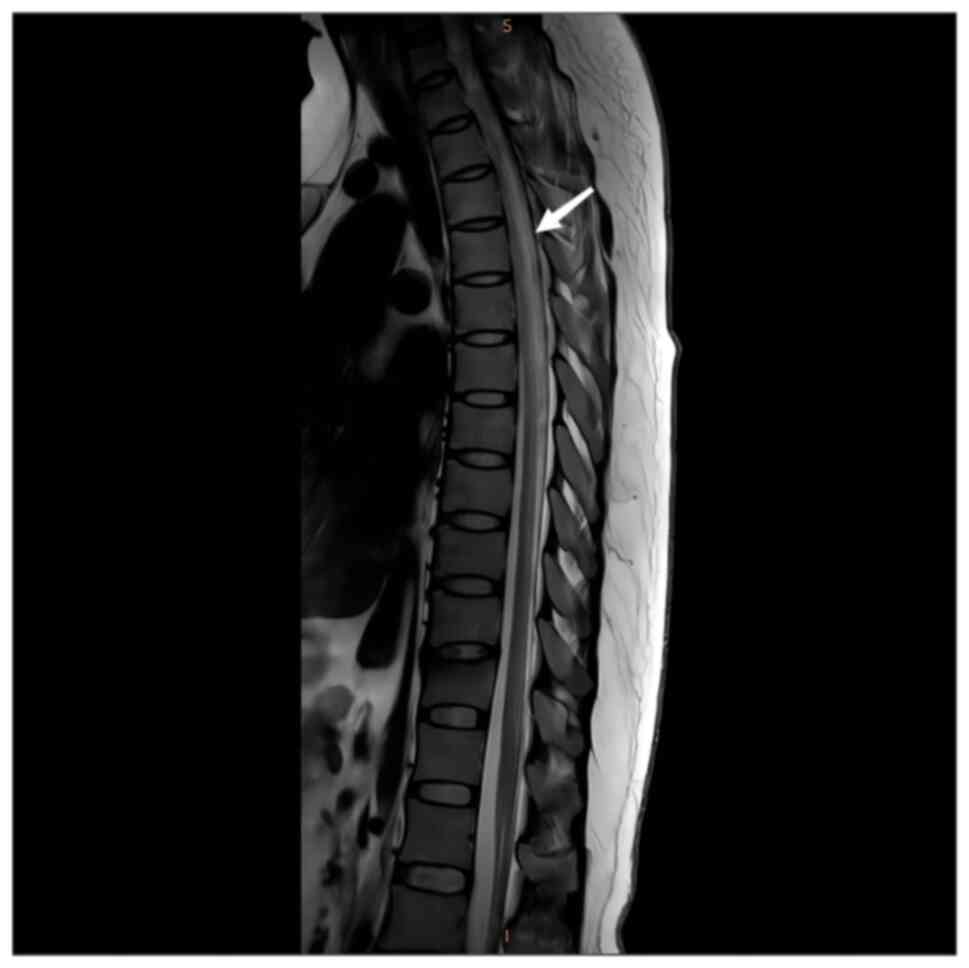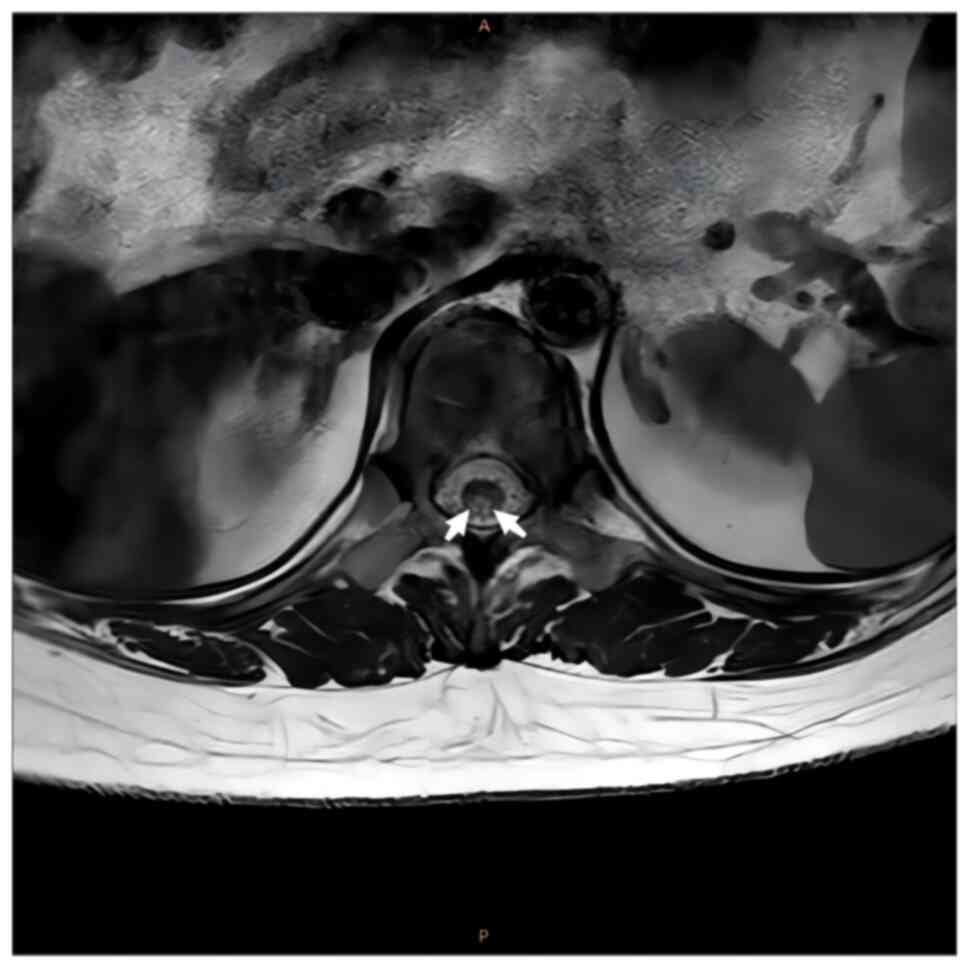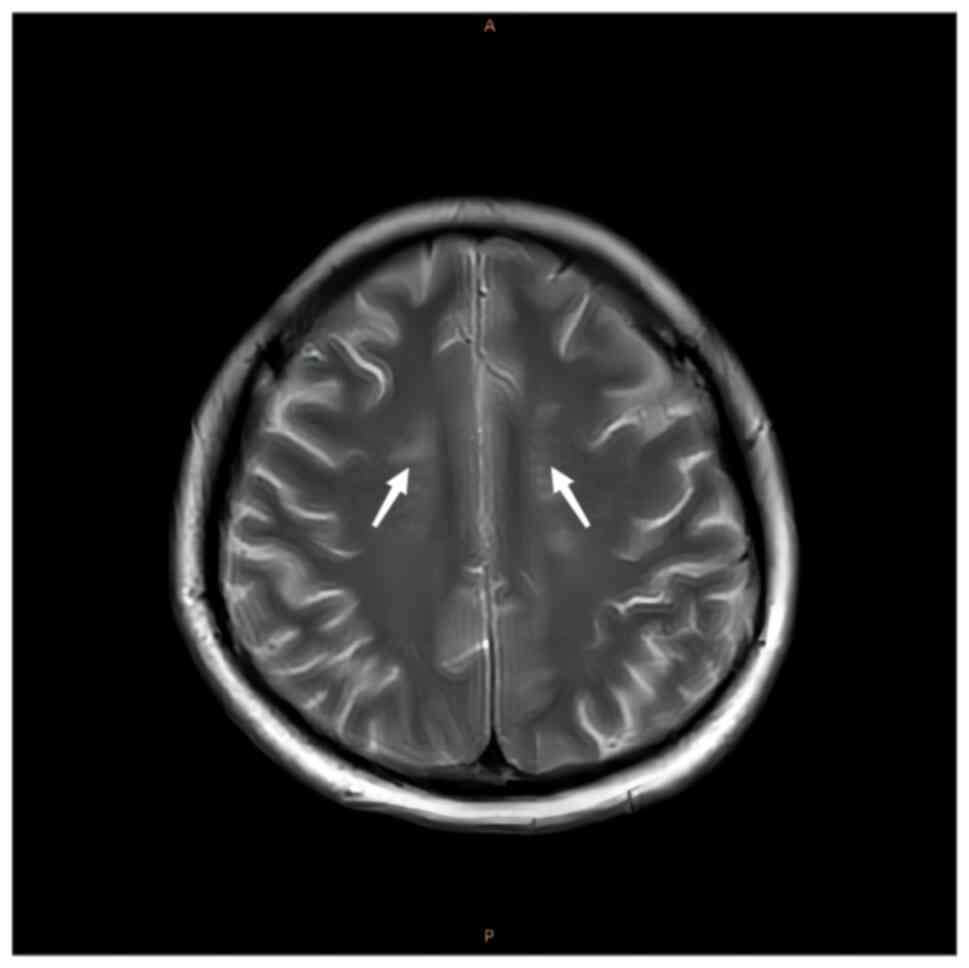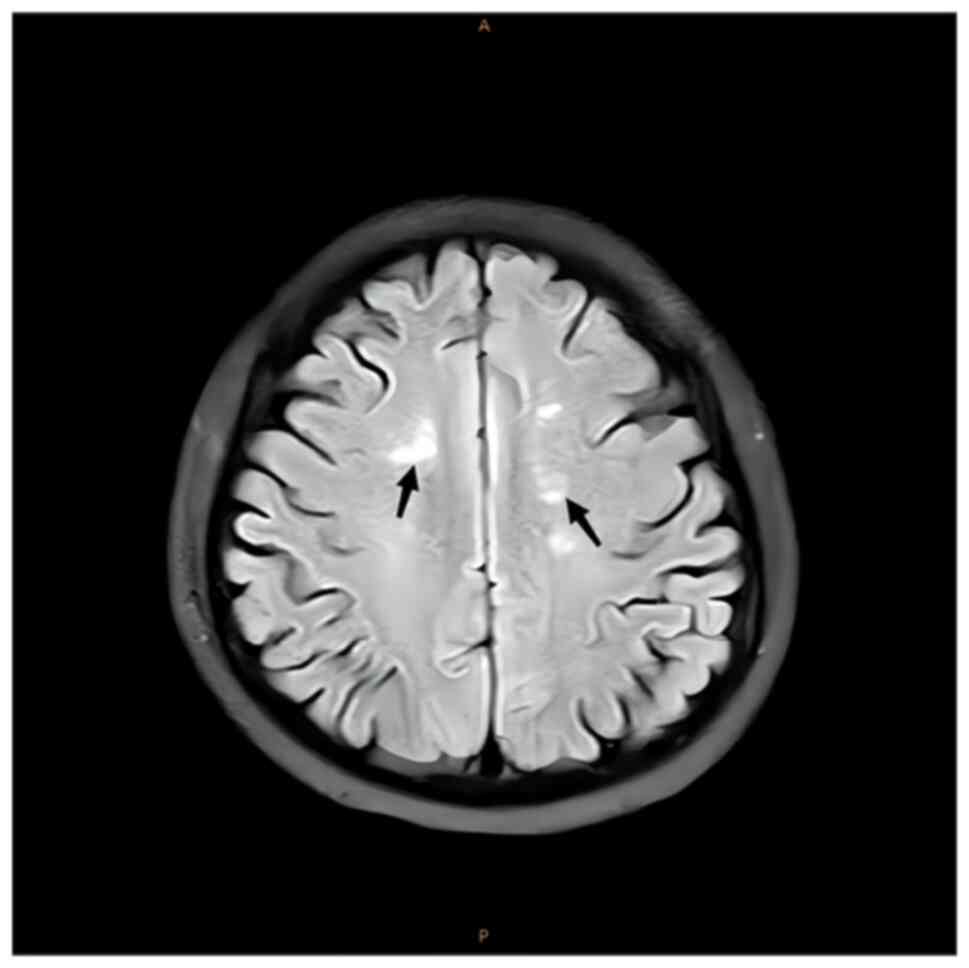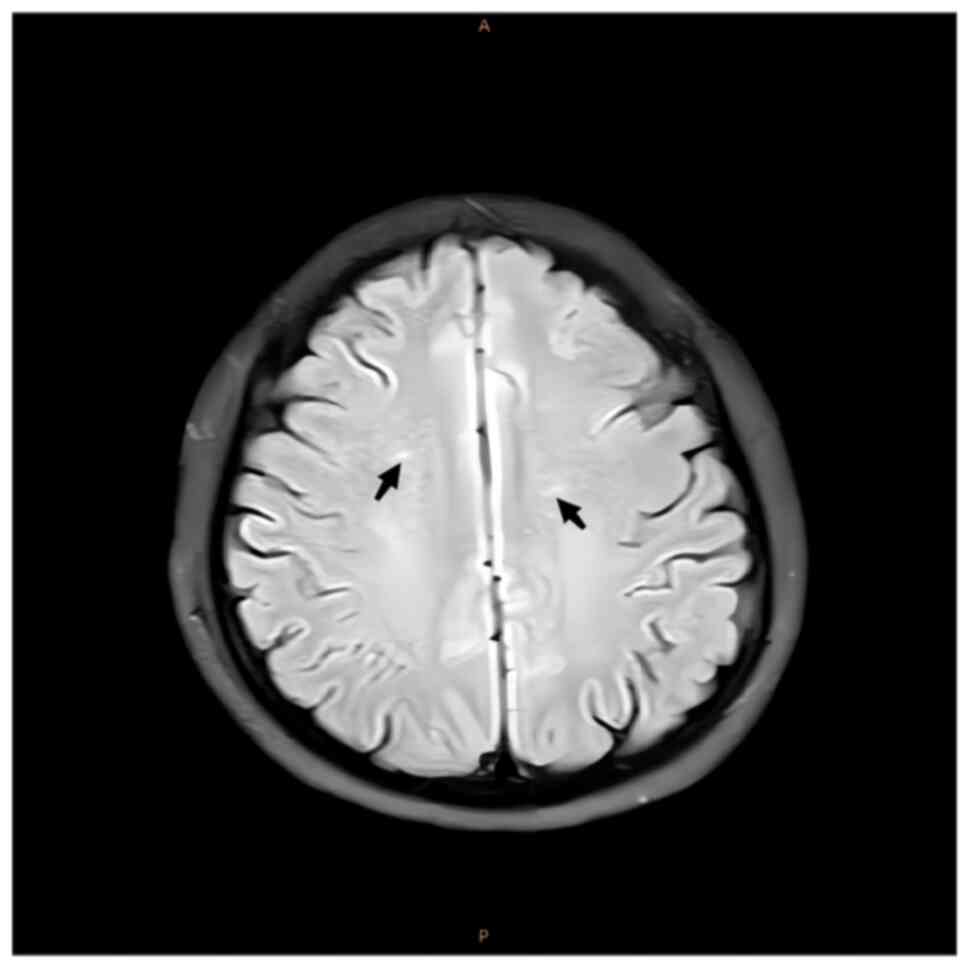Abnormal brain changes in a patient with vegetarian diet‑induced subacute combined degeneration: A case report
- Authors:
- Published online on: September 5, 2023 https://doi.org/10.3892/etm.2023.12190
- Article Number: 491
Abstract
Introduction
Subacute combined degeneration (SCD) is a neurological disease caused by reduced intake, insufficient absorption or abnormal metabolism of vitamin B12, which mainly involves the posterior and lateral cords of the spinal cord and peripheral nerves (1,2). Its clinical manifestations mainly include numbness of the lower limbs, deep sensory abnormalities, ataxia and spastic paralysis, and the white matter of the brain and optic nerves may also be involved in severe cases (3). The age of onset is mainly during middle age (45-64 years), with no significant differences between men and women, and most cases are subacute or chronic in onset, with slow progression (4,5). SCD has certain characteristic manifestations on MRI images. The typical manifestation of MRI is long T2 signals in the posterior and lateral cord of the spinal cord, and ‘stripe like’ or ‘patchy’ lesion signals can be seen in the sagittal position of the posterior spinal cord; the characteristic ‘anti rabbit ear sign’, ‘inverted V-shaped sign’, and ‘figure-eight sign’ can be found in the axial position of the posterior part of the spinal cord (3). The neurological damage of SCD is reversible in the early stage and the key to its cure is early diagnosis and timely treatment; if left untreated, it causes irreversible damage to the nervous system and disability (6). To the best of our knowledge, there are no previous reports of brain lesions caused by SCD. However, in the present case, symmetrical demyelinating changes were observed in the patient's brain. The aim of the present study was to report on the imaging manifestations of SCD brain lesions and to improve the understanding of SCD, thereby reducing the likelihood of misdiagnosis and incorrect treatment.
Case report
A 36-year-old female patient was admitted to the Affiliated Hospital of Gansu University of Chinese Medicine (Lanzhou, China) in December 2021. The main complaints were numbness and weakness in both lower limbs for >2 months, and reported aggravated walking difficulties for 1 week prior to presentation. In addition, the patient appeared sluggish and had significant memory loss. The patient reported no other specific illnesses but had consumed a vegetarian diet for 7 years. Furthermore, there was no personal or family history of other diseases.
Physical examination
The patient exhibited a clear mind and indifferent expression. Her thinking ability, comprehension, memory and calculation skills were decreased, in addition to difficulties with orientation. There was increased limb muscle tone, bilateral Hoffmann's, Babinski's and Chaddock's signs were positive. The patient did not cooperate during the depth of sensory examination of the limbs, bilateral finger to nose and alternate motion. Both the bilateral heel-knee-tibia test and Romberg's sign test were negative.
Electromyography did not elicit any sensory nerve conduction velocity of the right superficial peroneal nerve and double posterior tibial nerves, meaning a possible lesion in the peripheral nerve. The sensory conduction velocity of the left superficial peroneal nerve and the potential amplitude were decreased compared with expected values. The motor nerve transmission velocities of the double common peroneal and tibial nerves were normal, while the amplitude of the evoked action potential was decreased compared with expected values. Prolonged incubation period of the H-reflex of the left tibial nerve was noted.
Laboratory examinations
The results of blood tests revealed the following abnormal findings: Homocysteine (Hcy), 92.9 µmol/l (normal range: 0-15 µmol/l); and serum vitamin B12, 92.41 pg/ml (normal range: 197-771 pg/ml). Other blood test results were within the expected ranges. Gastroscopy revealed the presence of chronic gastritis.
Imaging examinations
Magnetic resonance imaging (MRI) of the cervical and thoracic spinal cord indicated an abnormal T2-weighted intramedullary signal with a high signal (Figs. 1 and 2). Axial images indicated that the lesions mainly occupied the posterior portion of the spinal cord in a ‘figure-eight sign’ (Figs. 3 and 4). MRI of the brain demonstrated spot-like and short-stripe abnormal signals that were distributed symmetrically in the centrum semiovale, with equal or a slightly low signal intensity on T1W1 and a slightly high signal intensity on T2W1 (Fig. 5) and hyperintensity on fluid-attenuated inversion recovery (FLAIR; Fig. 6). Diffusion-weighted imaging revealed low signal intensity (Fig. 7) and the long axis of the lesion was perpendicular to the lateral ventricles. The patient was finally diagnosed with SCD.
Treatment
The patient was treated with the following: Vitamin B1 injection [100 mg, intramuscular injection, every day (QD)], and intravenous mecobalamin [1 mg, intravenous injection (IV), QD] to improve nerve function and increase vitamin B12 levels; Intravenous sodium chloride (100 ml, IV, QD), and oral folic acid tablets (5 mg, per os, QD) cooperating with mecobalamin, to improve symptoms.
Outcome and follow-up
After 6 months of follow-up treatment, cranial MRI images demonstrated that the symmetrical spot-like and short-stripe abnormal signals in the centrum semiovale were reduced compared to previous scans (Fig. 8). The Hcy and serum vitamin B12 levels of the patient were also within the normal range.
Discussion
The main cause of SCD, a neurological condition characterised by demyelination in the posterior and lateral columns of the cervical spine and spinal cord, is vitamin B12 deficiency (7). The clinical signs of SCD of the spinal cord are determined by the degree of damage to the peripheral nerve, posterior cord and pyramidal tracts (8,9). If the peripheral nerves are predominantly affected, SCD manifests as decreased limb muscle tension, decreased tendon reflexes and a flaccid paralysis. If the pyramidal tracts are predominantly affected, SCD manifests as limb rigidity, increased muscle tension, tendon hyperreflexia and positive pathological signs. Sphincter dysfunction may also be present in advanced stages of the disease. In the present study, an increase in muscle tension in the limbs was detected and bilateral Hoffmann's, Babinski's and Chaddock's signs were positive. SCD typically occurs in the cervical spinal cord and the lesions usually cause a ‘figure-eight’ change in the posterior cord.
While SCD rarely causes changes in the brain, in the present study, the patient with SCD demonstrated abnormal changes in the white matter of the brain. SCD of the spinal cord is a neurological disease caused by vitamin B12 deficiency; of note, vitamin B12 is essential for development of the central nervous system, formation of the initial myelin sheath and maintenance of normal neurological function (4,10). Therefore, vitamin B12 deficiency leads to demyelination of the external and dorsal spinal columns, which can result in progressive weakness, sensory ataxia and paraesthesia (11). In the present study, the patient's lesions were mainly in the bilateral centrum semiovale as there was a high signal in this region on T2 MRI and FLAIR. In the present study, the lesions were symmetrical and perpendicular to the long axis of the bilateral lateral ventricles, which is a characteristic manifestation of SCD. These lesions are either directly or indirectly related to the vitamin B12 deficiency observed in the patient.
Vitamin B12 deficiency mainly affects glial cells, the myelin sheath and the interstitium, and causes an increase in the number of positive keratinocyte acidic proteins in astrocytes and microkeratinocytes (12-14). Vitamin B12 is converted by absorption and transport into two active components, methylcobalamin and adenosylcobalamin. Methylcobalamin is a coenzyme of methionine synthase and is involved in methionine and homocysteine metabolism. In the methionine cycle, methylcobalamin catalyzes the conversion of homocysteine to methionine as a coenzyme of N5-methyltetrahydrofolate transmethylase, and when tissues are deficient in vitamin B12, the methionine cycle fails to proceed normally, resulting in an increase in serum homocysteine concentration. Adenosylcobalamin deficiency leads to mitochondrial dysfunction, reduced myelin synthesis and incorporation of abnormal fats into neuronal lipids (15). The typical pathological changes of SCD are multifocal demyelination, vacuolation and axonal degeneration. The hyperhomocysteinemia exhibited in the patient of the present study was due to a dysfunction in methionine metabolism caused by a vitamin B12 deficiency, which manifested as an increase in Hcy, resulting in hyperhomocysteinemia (16). Previous studies have reported that Hcy is highly sensitive to vitamin B12 deficiency, lack of vitamin B12 in plasma may cause an increase in Hcy, which can serve as an indirect diagnostic basis for vitamin B12 deficiency, and hyperhomocysteinemia is a risk factor for SCD, and therefore may be associated with the degree of disability caused by this disease (17,18).
The main causes of vitamin B12 deficiency include pernicious anaemia, vitamin B12 malabsorption [congenital or acquired (e.g. senile gastric acid deficiency, stomach or ileal resection, chronic pancreatic insufficiency and Crohn's disease)], medications (e.g. colchicine and neomycin), increased demand (e.g. hyperthyroidism, α-thalassaemia) or inadequate intake (e.g. vegetarian diet) (19). SCD typically develops after middle age, occurs equally between the sexes, and can have a subacute or chronic onset and gradually worsens (4,5).
It can be misdiagnosed as other types of neurological demyelinating diseases, such as Guillain-Barre syndrome, multiple sclerosis or alcoholic encephalopathy (20). The clinical treatment for SCD of the spinal cord is vitamin B12 and folic acid supplementation, nutritional support therapy and aggressive treatment of the primary cause if a clear primary disease is identified (21).
SCD can result from a vegetarian diet (12,22,23). Although, to the best of our knowledge, there have been no reports to date regarding alterations in the brain of patients with SCD, when patients with SCD have neurological symptoms, clinicians should consider that this condition may be accompanied by inflammatory demyelination of the brain. In conclusion, because of the rarity and non-specific imaging characteristics of SCD, the brain damage SCD causes can be difficult to diagnose. Thus, the different symptoms, clinical course of the disease, laboratory test results and imaging findings should be considered in order to comprehensively diagnose SCD. A summary of the clinical and imaging features of the present study may aid the future diagnosis of SCD.
Acknowledgements
Not applicable.
Funding
Funding: No funding was received.
Availability of data and materials
The datasets used and/or analyzed during the current study are available from the corresponding author on reasonable request.
Authors' contributions
XL designed the study. XX collected relevant clinical data of the patient. XX and HL confirm the authenticity of all the raw data. XX and HL compared images of the patient before and after follow-up and queried relevant clinical data. All authors have read and approved the final manuscript.
Ethics approval and consent to participate
Not applicable.
Patient consent for publication
Written informed consent was obtained from the patient for publication of this report and accompanying images.
Competing interests
The authors declare that they have no competing interests.
References
|
Cao J, Su ZY, Xu SB and Liu CC: Subacute combined degeneration: A retrospective study of 68 cases with short-term follow-up. Eur Neurol. 79:247–255. 2018.PubMed/NCBI View Article : Google Scholar | |
|
Wu J and Jia J: Neurology. 3rd edition. People's Health Publishing House, Beijing, pp159-163, 2018. | |
|
Zhang YF, Liu YJ, Gan FZ and Zhang Q: Research progress on subacute combined degeneration of the spinal cord. J Ningxia Med Col. 41:206–210. 2019.(In Chinese). | |
|
Lee WJ, Hsu HY and Wang PY: Reversible myelopathy on magnetic resonance imaging due to cobalamin deficiency. J Chin Med Assoc. 71:368–372. 2008.PubMed/NCBI View Article : Google Scholar | |
|
Miscusi M, Testaverde L, Rago A, Raco A and Colonnese C: Subacute combined degeneration without nutritional anemia. J Clin Neurosci. 19:1744–1745. 2012.PubMed/NCBI View Article : Google Scholar | |
|
Zhang X, Liu XL and Liu Y: Diagnostic value of serum vitamin B12 and homocysteine detection in subacute combined spinal cord degeneration. J Mod Lab Med. 32(4)2017.(In Chinese). | |
|
Van Berkel B, Vandevenne J, Vangheluwe R and Van Cauter S: Subacute combined degeneration of the cervical and dorsal spinal cord in a 40-year-old male patient: A case report. Radiol Case Rep. 16:13–17. 2020.PubMed/NCBI View Article : Google Scholar | |
|
Turner MR and Talbot K: Functional vitamin B12 deficiency. Pract Neurol. 9:37–41. 2009.PubMed/NCBI View Article : Google Scholar | |
|
Puri V, Chaudhry N and Gulati P: Syringomyelia-like manifestation of subacute combined degeneration. J Clin Neurosci. 11:672–675. 2004.PubMed/NCBI View Article : Google Scholar | |
|
Chen Y, Chen MY, Wu MQ, et al: Clinical characteristics analysis of subacute combined degeneration of the spinal cord. China Health Standards Management, (013-011), 2022. | |
|
Sun W, Li G, Lai Z, Lu Z, Lin Y, Peng J, Huang J and Hu K: Subacute combined degeneration of the spinal cord and hydrocephalus associated with vitamin B12 deficiency. World Neurosurg. 128:277–283. 2019.PubMed/NCBI View Article : Google Scholar | |
|
Briani C, Dalla Torre C, Citton V, Manara R, Pompanin S, Binotto G and Adami F: Cobalamin deficiency: Clinical picture and radiological findings. Nutrients. 5:4521–4539. 2013.PubMed/NCBI View Article : Google Scholar | |
|
Kitamura T, Gotoh S, Takaki H, Kiyuna F, Yoshimura S and Fujii K: A case of vitamin B12 deficiency with involuntary movements and bilateral basal ganglia lesions. Rinsho Shinkeigaku. 56:499–503. 2016.PubMed/NCBI View Article : Google Scholar : (In Japanese). | |
|
Chen H, Li H, Li Y, Jing J, Raza HK, Zhang Z, Dong L, Ye X, Hua F and Cui G: Clinical and imaging characteristics of subacute combined degeneration complicated with white matter lesions in the brain: A report of five cases. Somatosens Mot Res. 35:119–123. 2018.PubMed/NCBI View Article : Google Scholar | |
|
Feng XT: The relationship between vitamin B12 deficiency and related diseases. Chin J Pract Neurol. 17:96–99. 2014.(In Chinese). | |
|
Kaptan K and Beyan C: Vitamin B12 deficiency as a cause of hyperhomocysteinaemia. Aliment Pharmacol Ther. 19(703)2004.PubMed/NCBI View Article : Google Scholar | |
|
Green R: Indicators for assessing folate and vitamin B-12 status and for monitoring the efficacy of intervention strategies. Am J Clin Nutr. 94:666S–672S. 2011.PubMed/NCBI View Article : Google Scholar | |
|
Ma C, Wang Ll, Wang L, Zhao D, Xiaodan XD, Wei ZH, Qin N, Xia F, Wang JC, Yang F, et al: The association between serum total homocysteine and subacute combined degeneration of spinal cord. Zhonghua Yu Fang Yi Xue Za Zhi. 55:1442–1448. 2021.PubMed/NCBI View Article : Google Scholar : (In Chinese). | |
|
Wang L and Song GJ: Report of a case of subacute joint degeneration of the spinal cord. Capital City Food Med. 29:2022. | |
|
Li HY, Chen H, Xu K, et al: Clinical characteristics of 107 patients with subacute combined degeneration of the spinal cord., 20, 20, Injury Funct Reconstruction 13: 456-569+66, 2018. | |
|
Wang YD, Zhang MJ and Li YX: MRI diagnosis of subacute combined degeneration of the spinal cord. Chin J Med Imaging. 135–366. 2002. | |
|
Hathout L and El-Saden S: Nitrous oxide-induced B12 deficiency myelopathy: Perspectives on the clinical biochemistry of vitamin B12. J Neurol Sci. 301:1–8. 2011.PubMed/NCBI View Article : Google Scholar | |
|
Lavoie MR, Cohen NC, Gregory TA and Weber PV: Subacute combined degeneration: A case of pernicious anaemia without haematological manifestations. BMJ Case Rep. 13(e234276)2020.PubMed/NCBI View Article : Google Scholar |



